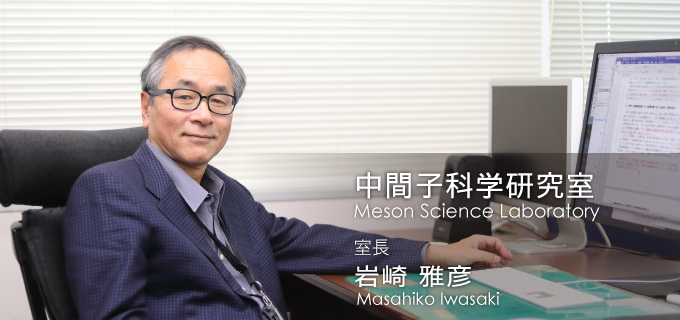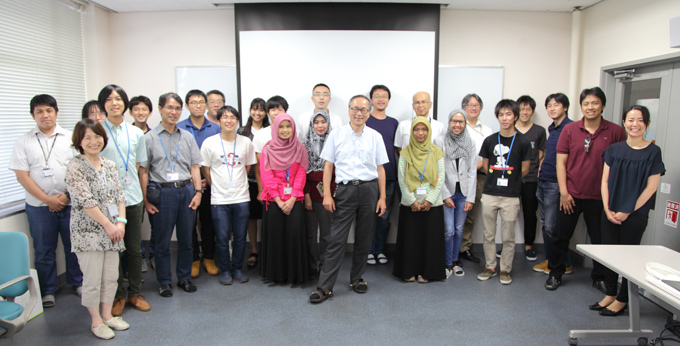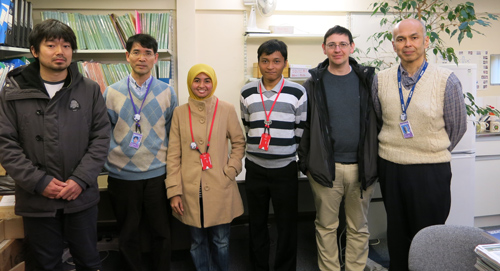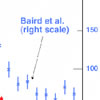Research Facility Development Division
- Accelerator Group
- Accelerator R&D Team
- Ion Source Team
- RILAC Team
- Cyclotron Team
- Beam Dynamics & Diagnostics Team
- Cryogenic Technology Team
- Infrastructure Management Team
- Research Instruments Group
- Automated Operation Technology Team
- BigRIPS Team
- SAMURAI Team
- Data System Team
- Detector Team
- Instrumentation Development Group
Nuclear Science Research Division
- Radioactive Isotope Physics Group
- Nuclear Dynamics Research Group
- Few-body Systems in Physics Laboratory
- Cosmic Radiation Laboratory
- Astro-Glaciology Research Unit
- Nuclear Many-body Theory Laboratory
- RHIC Physics Research Group
- Three-Body Nuclear Force Laboratory
- Meson Science RIKEN ECL Research Team
Accelerator Applications Research Division
Directly under the Nishina Center
Closed Laboratory
Meson Science Laboratory

- 1987年東京大学大学院理学系研究科物理学専攻 博士課程修了
- 1987年東京大学理学部附属 中間子科学研究施設 助手
- 1997年東京工業大学 助教授
- 2002年理化学研究所 主任研究員
- 2002年東京工業大学大学院 理工学研究科 連携教授
Staff


Research Areas
Particles like muons, pions, and kaons have finite life times, so they do not exist in natural nuclei or matters. Implanting these particles into nuclei/matters, exotic phenomena in varieties of objects can be studied from a new point of view. Kaon is a second lightest meson which has strange-quark as a constituent quark. It is expected that if one embed a kaon into nuclei, the sizes of the nuclei become smaller and forms a high density object beyond the normal nuclear density. Study of this object could lead better understanding of the origin of the mass of the matter, and may reveal the quark degree of freedom beyond the quark-confinement. Those properties can be studied by precise heavy pionic atom research in different angle. The other example is the weak interaction in nuclear matter. It can only be studied by the weak decay of hypernuclei, which have Lambda particle in the nuclei, Muon provides even wider variety of study from nuclear reaction to magnetism in matter. For instance, stopping positively charged muon in a material, we obtain information on the magnetic properties or the local field at the trapped site(muon-spin-relaxation method). Injecting negatively charged muon to mixture of deuterium and tritium, muon attracts surrounding atoms and is known to cause d-t fusions. In addition, the in-beam Mössabuer spectroscopy coupled with heavy-ion beams plays a complementary role to muon-spin-relaxation method. Mössbauer spectroscopy is one of the powerful tools to understand the chemical states and dynamic behaviors of localized atoms in condensed matters via hyperfine interaction. Theoretical research covers from the study of Quantum Hall system to the study string theory via matrix models. As is already clear, in our research we introduce different kind of impurities into nuclei/matters, and study new states of matter, new phenomena, or the object properties.
Research Subject
- Study of meson property and interaction in nuclei
- Origin of matter mass / quark degree of freedom in nuclei
- Materials science by muon-spin-relaxation method and Mössbauer spectroscopy
- Nuclear and particle physics studies via muon catalyzed fusion and ultra cold muon beam
List of Selected Publications
- M. Iwasaki, H. Bhang, J. Chiba, Choi Seonho, Y. Fukuda, T. Hanaki, R.S. Hayano, M. Iio, T. Ishikawa, S. Ishimoto, T. Ishiwatari, K. Itahashi, M. Iwai, P. Kienle, J.H. Kim, Y. Matsuda, H. Ohnishi, S. Okada, H. Outa, M. Sato, S. Suzuki, T. Suzuki, D. Tomono.:
"Search for strange tribaryon states in the inclusive He-4 (K-(stopped), p) reaction"
Nucl. Phys. A804, 186-196 (2008)
- S. Okada, G. Beer, H. Bhang, M. Cargnelli, J. Chiba, Seonho Choi, C. Curceanu, Y. Fukuda, T. Hanaki, R.S. Hayano, M. Iio, T. Ishikawa, S. Ishimoto, T. Ishiwatari, K. Itahashi, M. Iwai, M. Iwasaki, B. Juhasz, P. Kienle, J. Marton, Y. Matsuda, H. Ohnishi, H.:
"Precision measurement of the 3d ---> 2p x-ray energy in kaonic He-4"
Physics Letters B 653, 387-391 (2007).
- T. Suzuki, H. Bhang, J. Chiba, S. Choi, Y. Fukuda, T. Hanaki, R. S. Hayano, M. Iio, T. Ishikawa, S. Ishimoto, T. Ishiwatari, K. Itahashi, M. Iwai, M. Iwasaki, P. Kienle, J. H. Kim, Y. Matsuda, H. Ohnishi, S. Okada, H. Outa, M. Sato, S. Suzuki, D. Tomono.:
"Lambda d correlation from He-4(stopped K-, d) reaction"
Physicl Review C76, 068202 (2007)
- Y. Tanabe, T. Adachi, K. Suzuki, Y. Koike, T. Kawamata1, Risdiana, T. Suzuki1, and I. Watanabe.:
"Similarity between Ni- and Zn-Impurity Effects on the Superconductivity and Cu-spin Correlation in La-214 High-TC Cuprates: Review Based on the Hole Trapping by Ni"
Phys. Rev. B 83, 144521-1-6 (2011)
- F.L. Pratt, P.J. Baker, S.J. Blundell, T. Lancaster, S. Ohira-Kawamura, C. Baines, Y. Shimizu, K. Kanoda, and I. Watanabe.:
"Magnatic-Field-Induced Quantum-Phase-Transition in the Spin-Liquid Phase of a Frustrated Magnet"
Nature 471, 612-616 (2011)
- T. Lancaster, F.L. Pratt, S.J. Blundell, A.J. Steele, P.J. Baker, J.D. Wright, I. Watanabe, R.S. Fishman, and J.S. Miller.:
"Local Magnetism in the Molecule-Based Metamagnet [Ru2(O2CMe)4]3[Cr(CN)6] Probed with Implanted Muons"
Phys. Rev. B 84, 092405-1-4 (2011)
- Imao, H., Ishida, K., Kawamura, N., Matsuzaki, T., Matsuda, Y., Toyoda, A., Strasser, P., Iwasaki, M. and Nagamine, K.:
"Density effect in d-d muon-catalyzed fusion with ortho- and para-enriched D2"
Phys. Lett. B 658, 120-124 (2008)
- P. Bakule, D.G. Fleming, O. Sukhorukov, K. Ishida, F. Pratt, T. Momose, E. Torikai, B.G. garrett, K.A. Peterson, G.C. Schatz and D.G. Truhlar:
"State-selected reaction of muonium with vibrationally excited H2"
J. Phys. Chem. Lett. 3, 2755-2760 (2012)
- Bakule, P., Matsuda, Y., Miyake, Y., Nagamine, K., Iwasaki, M., Ikedo, Y., Shimomura, K., Strasser, P., and Makimura, S.:
"Pulsed source of ultra low energy positive muons for near-surface mSR studies"
Nuclear Instruments and Methods in Physical Research B 266, 335-346 (2008)
- T.Hashimoto et al.:
"Search for the deeply bound K−pp state from the semi-inclusive forward-neutron spectrum in the in-flight K− reaction on helium-3"
Prog. Theor. Exp. Phys. (2015) 061D01.





